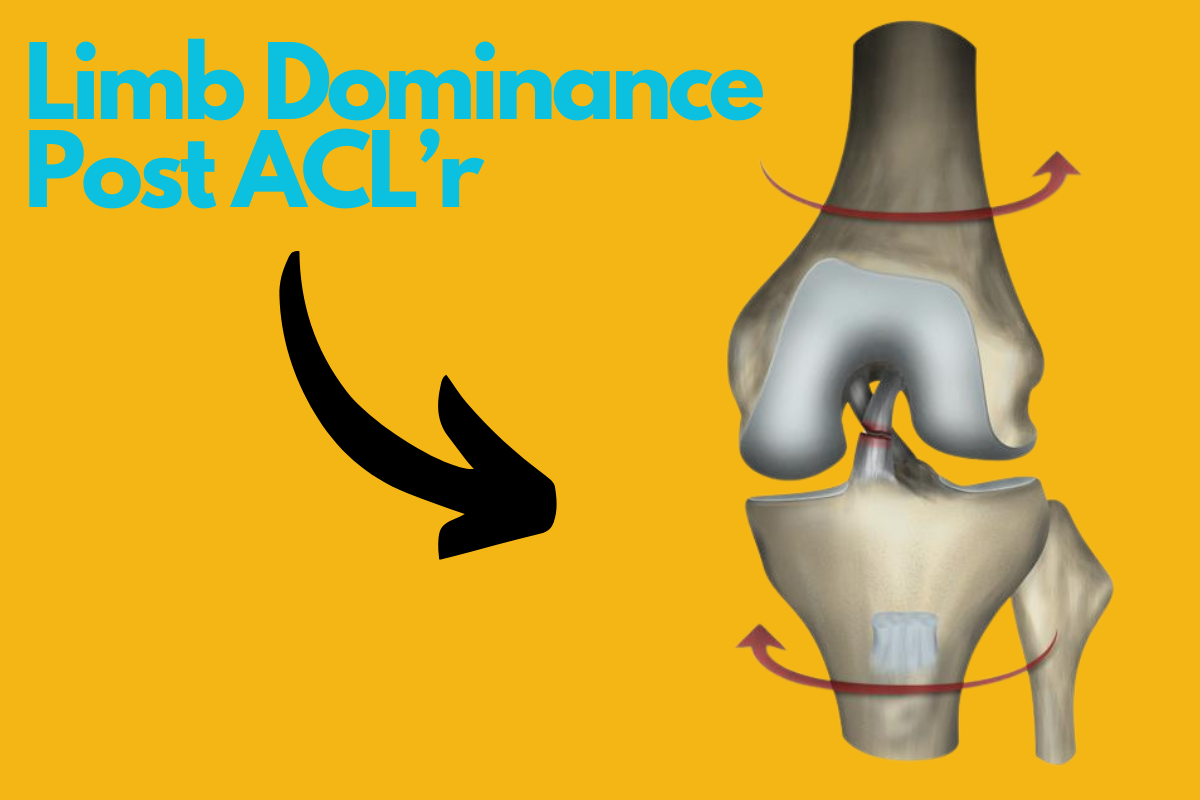
Does Limb Dominance Matter After ACL Reconstruction?
Here is a thought, how does limb dominance affects recovery after an ACL injury?
Understanding this concept can make a big difference in how recovery is tracked and managed. This article takes a big look into the study by Zumstein and colleagues, which explores the role of limb dominance in shaping functional movement symmetry in athletes recovering from ACL reconstruction.
The study gives explanations on how injured athletes’ dominant versus non-dominant limbs affect the results of common recovery tests, like the limb Symmetry Index (LSI)
& how this can influence return-to-sport decisions.
Using the findings from this research, we’ll break down the critical points you need to know as a physiotherapist.
In A Nutshell
Rapid Results:
Patients who injure their dominant leg tend to have higher LSI scores for knee extension compared to those with non-dominant leg injuries, likely due to the dominant leg’s naturally greater baseline strength. However, this effect does not seem to impact hamstring strength or functional hop tests.
Professional Takeaway:
Clinicians should consider limb dominance when interpreting LSI scores to avoid overestimating recovery progress in dominant leg injuries. Additionally, rehab should prioritise quadriceps strengthening, as quad LSI is a key predictor of functional performance and necessary for safe return to sport
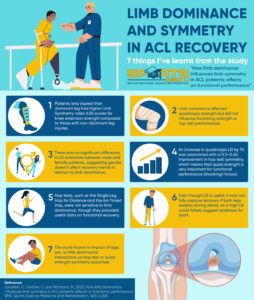
Aim Of The Study
This study aimed to explain how limb dominance shapes the symmetry of functional movements (measured by the Limb Symmetry Index, or LSI) in athletes recovering from ACL surgery, specifically when they’re cleared to return to sport—around nine months post-surgery.
Did You Know?
ACL of injuries are pretty common — approximately 69 out of every 100,000 people tear their ACL every year. 😬
A well known fact is that women are more likely to experience this than men.
Due to:
- Anatomical
- Hormonal
- Biomechanical differences.
They typically have a wider pelvis, which affects knee alignment, and greater ligament laxity influenced by hormonal fluctuations. Additionally, differences in neuromuscular control, such as landing mechanics and muscle activation patterns, increase their risk of ACL injuries
When it happens, about 75% of people end up needing surgery, which as we all know means a long and often grueling rehab process.
The rehab programmes are a collection of structured exercises designed to get patients back to sport safely while minimising the risk of injury.
Every phase of rehab has a purpose, at first regaining range, quad activation and function is the top priority. Then, rehab focuses on strength & neuromuscluar. control. Only when specific criteria are checked off and he knee is showing strong progress can we begin incorporating more explosive drills, to start returning patients to running and ultimately, sports.
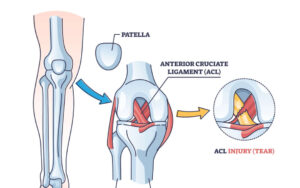
Strength Testing Is Non-Negotiable
Strength tests, balance assessments, and movement analysis are essential for tracking progress and making sure the knee is ready for the demands your placing them under (no matter if it’s stage 1 or 4 ).
Close monitoring may seem like over kill, but numerous research has shown that even after months of rehab, many patients still show a significant strength gap between their injured and uninjured leg—sometimes up to 30% weaker on the affected side.
That’s a major concern because lingering weakness increases the risk of reinjury and long-term issues like osteoarthritis
Hop tests, like the Single Leg Hop for Distance or the 6m Timed Hop, are commonly used to assess functional recovery. They aim to replicate the types of explosive movements required in sports.
They are great for a few reasons
- a) The objective data on how far and how fast an athlete can move
- b) Revealing compensations or imbalances that might not be obvious during standard strength tests.
And of course we cant forget the Limb Symmetry Index (LSI) – a metric comparing the injured leg’s strength and function to the healthy one.
The target for return to sport is AT LEAST 90% symmetry, but here’s where this study comes in.
Limb Dominance Can Skew Results.
If the non-dominant leg is injured, the strength gap might look worse than it is. If the dominant leg is injured, its natural strength advantage can mask deficits, making recovery seem more complete than it actually is.
If clinicians don’t factor this in, athletes may return too soon—setting them up for reinjury
Thats no bueno
Methods Of The Study
Focus: How limb dominance impacts functional symmetry (LSI) during ACL recovery
Study Design
- Type: Retrospective cross-sectional analysis of medical records.
- Timeframe: Patients who underwent ACL reconstruction between Feb 2018–Mar 2020, tested 9 months post-surgery.
- Inclusion Criteria:
- Age 18–60 years.
- Single-bundle ACL reconstruction using a semitendinosus (hamstring) autograft.
- Exclusion Criteria:
- Additional knee surgeries (e.g., meniscal repair, cartilage interventions).
- ACL re-ruptures, neurological disorders, or inconsistent limb dominance reports.
- Missing data or full-contact injuries (e.g., high-impact trauma).
Participants
- Sample: 100 patients (66 male, 34 female) from a Swiss sports orthopedic clinic.
- Rehabilitation:
- Standardised 9-month protocol: 2x/week physiotherapy.
- Focused on mobilisation, strength, sensorimotor training, and sport-specific drills (e.g., jumping, pivoting).
- Limb Dominance: Determined by asking, “Which foot would you use to kick a ball?”
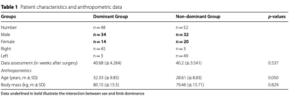
Performance Testing
- Timing: Conducted ~9 months post-surgery (40.4 ± 3.9 weeks).
- Warm-Up: 10 minutes on a cycling ergometer (~50 W).
- Tests:
- Isokinetic Strength:
- Measured knee extensor/flexor strength at 60°/s using a dynamometer.
- Normalised torque (Nm/kg) calculated from best repetitions.
- Hop Tests:
- Drop Jump (DJ): From 20cm platform; ground reaction forces normalised to body mass.
- Single-Leg Hop for Distance (SHD): Maximal forward hop distance.
- 6m Timed Hop: Speed measured over 6 meters.
- Isokinetic Strength:
-
- Limb Symmetry Index (LSI): Calculated as (injured leg / uninjured leg) × 100% for all tests.
Results of The Study
- 100 ACL reconstruction patients: 48 injured their dominant limb, 52 injured the non-dominant limb.
- No differences in age, sex, or physical characteristics between groups.
Limb Dominance & Sex:
- Males: 51.5% injured dominant limb.
- Females: 41.2% injured dominant limb.
- No significant link between sex and which limb was injured.
Findings on Limb Symmetry (LSI):
- Knee Extensor (quad) Strength:
- Patients who injured their dominant leg had higher LSI (better symmetry) compared to non-dominant injuries (p=0.030).
- No Differences Found:
- Quad strength, drop jump, single-leg hop, or 6m timed hop symmetry.
- Age, sex, and sex-limb dominance interactions had no impact on outcomes.
Predictive Relationship:
- Quad strength symmetry (LSI) predicted hop test performance:
- For every 1% increase in quad LSI:
- Drop Jump symmetry improved by 0.4%
- Single leg Hop symmetry improved by 0.3%
- For every 1% increase in quad LSI:
- Translation: Stronger quads = better jumping symmetry, but other factors (e.g., coordination, balance) also contribute.

So, Does Limb Dominance Matter?
Bottom line – Limb dominance is importnat in ACL recovery, especially when assessing quad strength.
This study shows that patients who injure their dominant leg tend to have higher Limb Symmetry Index scores for knee extension compared to those with non-dominant leg injuries.
Why?
Because the dominant leg naturally starts off stronger. Even after an injury, its baseline strength can mask deficits, making LSI scores look better than they actually are.
On the other hand, when the non-dominant leg is injured, its lower starting strength makes post-injury weaknesses more obvious, resulting in a lower LSI score.
An interesting observation coming from the study is that this doesn’t seem to affect hamstring strength (even though the graft was used from the hamstring) or functional hop tests, implying that dominance mainly affects quad strength rather than overall limb function.
Gender
Sex of the person is another thing that doesn’t seem to influence LSI outcomes
The study shows that regardless of whether a patient is male or female, limb dominance patterns and recovery trends remain similar.
This means that rehab should be based on individual strength baselines rather than broad sex-based expectations.
The Quad
A particularly important finding is the predictive relationship between quad LSI and functional performance.
For every 1% increase in quad LSI, hop test symmetry improves by 0.3–0.4%.
Since explosive movements like jumping and landing rely heavily on knee extension, restoring quad strength should be a top priority in rehab.
Without it, patients may struggle to achieve balanced movement patterns, increasing their risk of reinjury.
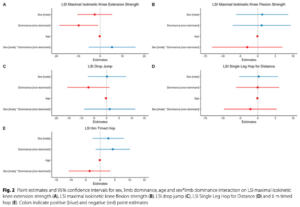
A Few Things To Consider
The Tests
When evaluating the effectiveness of LSI in assessing post-injury recovery, it’s important to consider both its strengths and limitations.
Hop tests, such as the single-hop for distance and drop jump , are commonly used to gauge functional performance.
While it’s thought that they are reliable measures, they may not be particularly sensitive to limb dominance.
This means that even though these tests give useful data on a patient’s ability to generate force and absorb impact, they might not fully capture how dominance influences recovery.
Limb Symmetry Index
LSI helps address this by directly comparing the injured limb to the uninjured one, reducing the impact of biological variability between people.
Since each person’s
- Baseline strength
- Flexibility
- Biomechanics
are different, this within-subject comparison gives a “clearer” picture of recovery progress.
That said, LSI is far from perfect my friends
This is because it only compares the injured limb to the uninjured one, without accounting for overall strength deficits. If both legs become weaker during rehab due to disuse, a high LSI could falsely suggest readiness for sport despite inadequate strength
ACL Graft
Another factor influencing recovery is the type of graft used in ACL reconstruction.
Hamstring autografts, for instance, have been linked to persistent knee flexor deficits. Since a portion of the hamstring tendon is harvested to reconstruct the ACL, the affected muscles may struggle to regain full strength post-surgery.
This can have long-term implications for knee stability and overall function, particularly in athletes who rely on explosiveness.
Sample Bias
No study is without limitations. One main issue in this research is sample bias.
With a male-dominated cohort (66 males vs. 34 females), the findings may not fully apply to female athletes, who often show different neuromuscular patterns and injury risks.
Additionally, since the study is retrospective, there is no pre-injury data to compare against, making it difficult to determine whether observed asymmetries existed before injury.
Clinical Tips
- Adjust LSI Benchmarks Based on Limb Dominance
Since dominant limbs typically have greater baseline strength, their post-injury LSI scores can be misleading. To account for this, use a higher target of 95% LSI for dominant limb injuries and a slightly lower threshold of 85% for non-dominant injuries to reflect realistic recovery expectations. This prevents overestimation of functional readiness. - Go Beyond LSI
While LSI is a useful metric, it should be combined with isokinetic strength (or handheld dynonometer) tests and movement-quality assessments so that the whole picture can be seen. Hop tests alone may not detect underlying deficits, so integrating biomechanics assessments, and strength measures ensures a more accurate recovery picture. - Prioritise Quadriceps Strength
Quadriceps weakness is a common issue post-ACL reconstruction and is strongly linked to poor functional performance. Emphasise quadriceps strengthening throughout rehabilitation, particularly for dominant limb injuries where strength imbalances can be masked by inflated LSI scores. - Interpreting LSI Scores
LSI can be misleading if viewed in isolation. Dominant limb injuries may result in artificially high LSI values due to pre-existing strength advantages, potentially masking deficits. Always consider limb dominance when analysing LSI scores.
References:
- Abrams G, Harris J, Gupta A, McCormick F, Bush-Joseph C, Verma N, et al. Functional performance testing after anterior cruciate ligament reconstruction: a systematic review. Orthopaed J Sports Med. 2014;1–10
- Bryant, A.L., Kelly, J. and Hohmann, E., 2008. Neuromuscular adaptations and correlates of knee functionality following ACL reconstruction. Journal of orthopaedic research, 26(1), pp.126-135.
- Nawasreh Z, Logerstedt D, Cummer K, Risberg M, Risberg MA, Snyder-Mackler L. Functinal performance 6 months after ACL reconstruction can predict return to participation in the same preinjury activity level 12 and 24 months after surgery. J Sports Med. 2018;52(6):375
- Zumstein, F., Centner, C. and Ritzmann, R., 2022. How limb dominance influences limb symmetry in ACL patients: effects on functional performance. BMC Sports Science, Medicine and Rehabilitation, 14(1), p.206.



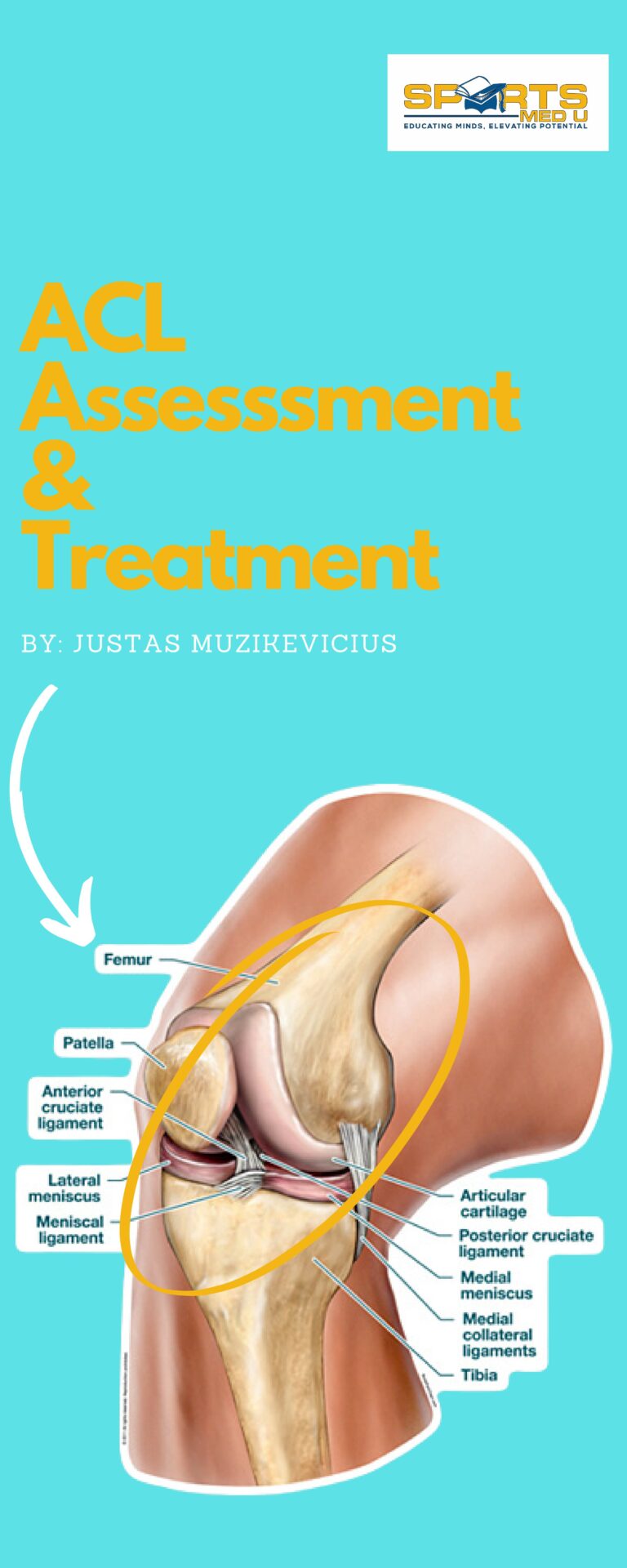




Leave a Reply